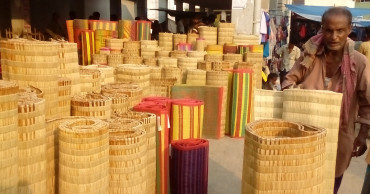loan assistance
EU scales up assistance for fire victims in Cox’s Bazar
The European Union has scaled up its support providing an additional €150,000 for the Rohingyas affected by the massive fire that swept through Rohingya camps in Cox’s Bazar earlier this month.
This follows the initial assistance of €500,000 announced last week as an immediate response to the blaze.
Also Read: Rohingya Camp Fire: Australia announces additional $10mn for affected people
The aid will directly benefit 27,500 of the most affected people.
“The fire has caused many Rohingya refugees, who have lived in displacement in camps over the past three years, to yet again lose almost everything,” said Daniela D'Urso who oversees the EU’s humanitarian response in Bangladesh.
“The additional funding from the European Union will ensure our partners on the ground are able to provide essential assistance to those most in need.”
This EU-funding supports the Bangladesh Red Crescent Society (BDRCS) in delivering much-needed assistance through the distribution of ready-to-eat food packs, hygiene kits and water buckets, to ensure the daily needs of the affected refugees are met during displacement. The funding is part of the EU’s overall contribution to the Disaster Relief Emergency Fund (DREF )of the International Federation of Red Cross and Red Crescent Societies (IFRC), said the EU Embassy in Dhaka on Thursday.
Also Read: Rohingya camp fire: 5 killed, hundreds rendered homeless
More than 10 people were killed and nearly 50,000 were affected, including injured and missing refugees, after a huge fire broke out on 22 March in Cox’s Bazar’s crowded Rohingya camp settlements.
Following the blaze, a number of facilities, including more than 10,000 homes, hospitals, learning centres, mosques and distribution points, have subsequently been destroyed or heavily damaged.
The European Union together with its Member States is the world's leading donor of humanitarian aid.
Relief assistance is an expression of European solidarity towards people in need around the world.
It aims to save lives, prevent and alleviate human suffering, and safeguard the integrity and human dignity of populations affected by natural disasters and man-made crises.
Through its European Civil Protection and Humanitarian Aid Operations (ECHO), the European Union helps over 120 million victims of conflicts and disasters every year. For more information, please visit ECHO's website.
The European Commission has signed a EUR 3 million humanitarian contribution agreement with the International Federation of Red Cross and Red Crescent Societies (IFRC) to support the Federation's Disaster Relief Emergency Fund (DREF).
The Disaster Relief Emergency Fund was established in 1985 and is supported by contributions from donors. Each time a National Red Cross or Red Crescent Society needs immediate financial support to respond to a disaster, it can request funds from the DREF.
4 years ago
Satkhira’s ‘mele’ mat industry faces extinction
A crisis of raw materials , low prices of finished goods and availability of cheaper alternatives are pushing the once thriving ‘mele’ mat industry of Satkhira towards extinction.
“The demand for ‘mele’ mats came down due to availability of plastic mats,” said Kawsar Ali, a wholesale mat trader of Sultanpur Boro Bazar in Satkhira who has been involved with the trade for 30 years.
A medium-sized plastic mat is sold at Tk 200-220 whereas a ‘mele’ mat of the same size costs Tk 300-350. “People are basically going for the cheaper alternative,” he said.
Many mat artisans are changing professions. But it was not always like this.
Only two decades ago, the business was brisk and mats from Satkhira were supplied all over the country.
Ninety percent families of Tetulia village in Ashashuni upazila used to be involved with mat production in the early 2000s, locals said. The number is now dwindling and at present, a small number of families are involved with the trade.
Many artisans are barely managing to hold on to the profession.
Gobinda Mondol, 55, is one of them. He said ‘mele’, a type of grass used as raw material for making the mat, is scarce now and costs much.
“Tk 500 is needed to make a big-sized mat and it’s sold for Tk 600. It takes time to make a mat and it’s really difficult to run family with the paltry income,” he said.
Tarapodo Mondol, 60, of Joduardangi village of the same upazila, said they have been making mats for generations. He recalled how ‘mele’ was once widely cultivated in the area.
“We used to produce 200 to 250 pairs of mats every week but the number has come down to eight to 10. As a result, the mat industry is on the verge of extinction,” he said.
Tarapodo said people involved with the mat trade had changed profession to feed their families.
Nasim Faruk Khan Mithu, President of Satkhira Chamber of Commerce and Industry, said the industry has suffered serious setback. “Those who were involved with this profession are now living in inhuman condition,” he said.
Stakeholders have urged the government to take prompt steps. They said it will soon cease to exist if the producers are not provided with necessary loan assistance.
5 years ago


